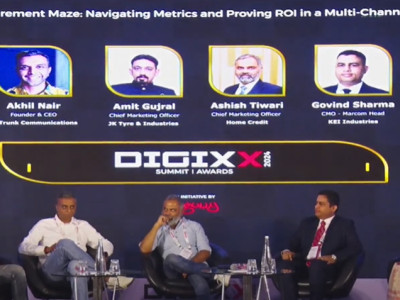The tailwinds propelling OOH advertising in India towards growth in 2024
Out-of-home (OOH) advertising in India is expected to register impressive growth in 2024. As in the case of most industries, the OOH industry, too, is leveraging the innovation potential of Artificial Intelligence. As per Statista, Ad spending in the Out-of-Home Advertising market is projected to reach US$589.70 million in 2024. The largest market is Traditional Out-of-Home Advertising with a market volume of US$419.80 million in 2024.
Speaking to Adgully, Arijit Charkrabarti, Vice President of Strategy and Insights at GroupM OOH Solutions, underscored the swift growth witnessed in the outdoor medium in 2023, particularly within the DOOH sector, which has consistently shown double-digit growth over the past three years.
To delve deeper into this, Adgully reached out to some leading media experts and OOH agencies to understand the influence of technology on advertising strategies, emerging trends shaping the industry, and the exciting prospects that lie ahead in 2024.
Gains expected in the OOH and DOOH advertising sector in India
Arijit Charkrabarti observed, “Outdoor has been the fastest growing medium in 2023 as per GroupM TYNY. This pace is expected to improve further into this new year on the back of faith reposed by clients in this media vehicle and the phenomenal innovation opportunities that this medium represents. Within the OOH segment DOOH has been consistently showing double digit growth in percentage terms over the last 3 years. A cursory visit to any of the top metros will show the effects of DOOH on its evolving skyscape. 2023 has been the year when DOOH matured from being present in just airconditioned / controlled spaces to now being visibly present on roadsides as well. Brightly-lit and impactful best describe the latest set of Digital OOH billboards that have started dotting Mumbai, Ahmedabad, and Pune to name a few.”
Arjun Raj, CEO/Founder, FlashDOOH, predicted, “We will see a big spike in ad spending, compared to other election years. We can expect around 12% growth in OOH and with the elections, we can expect around 10% more.”
In reflecting on the 2019 elections, Jayesh Yagnik, CEO, MOMS Outdoor, observed a consistent 5% visibility for political parties throughout the year. He added, “However, the real game-changer unfolded in April, marking a remarkable 21% spike as the elections kicked off. Anticipating upcoming trends, we project an even more dynamic landscape this year, fuelled by the surge in Digital Out-of-Home (DOOH) advertising.”
With brands leveraging this medium, there is an unprecedented opportunity for enhanced voter engagement. Through interactive campaign messages accessible on mobile devices, reaching offline-to-online voters via mobile phones and various digital platforms, strategically placed around consumers at their recreational places and high-dwell locations, the stage is set for a revolutionary shift in how political narratives connect with the electorate.
Influence of technology in OOH and DOOH advertising strategies
According to Charkrabarti, “Technology is the critical piece in the OOH growth story puzzle. Last year there were multiple campaign implementations with QR codes which allowed the humble OOH flex to traverse from offline to online. At the same time connected DOOH screens led to programmatic campaigns becoming more mainstay at niche touchpoints. Development of DOOH and standardized audience measurement brought OOH closer to realizing its potential by being transacted not just basis sites – but the number of impressions that it caters to. This has led to OOH realizing the value of conversations from one to many to at least one to few.”
And lastly with the development in 3D anamorphic tech – it is no longer necessary to have L Shaped DOOH screens to drive 3D anamorphic. The latest tech allows for creating artificial depth perception to display beautiful 3D anamorphic content on regular 2Dimensional Digital OOH screens, he added.
“With AI in the scene, we are witnessing new AdTech companies foraying into campaign Reporting, Media planning, etc. This will help optimize and streamline media spending,” noted Arjun Raj.
Merlin Coutinho, Marketing Head, Lemma, pointed out, “Technology is fostering growth in OOH and DOOH advertising by enhancing ad serving and screen quality. For example, programmatic DOOH platforms allow for automated, targeted ad placements based on real-time data, making campaigns more dynamic, personalized, and visually appealing, thus significantly boosting their effectiveness and reach In 2024, India’s DOOH advertising is leading with a contextual approach, leveraging environmental cues like weather and location for contextual relevance, thus respecting user privacy while maintaining effectiveness.”
Emerging trends shaping the OOH and DOOH advertising industry in India in 2024
“Standardized audience measurement is the cornerstone for OOH to break through the low single digit share of the advertising rupee. Clients have shifted focus from soft campaign indicators like buzz with the trade, sentiment etc. to looking at measuring OOH on the back the same parameters and metrics as the digital medium. This will be a continuing trend across 2024,” said GroupM’s Charkrabarti.
Innovation is another aspect that is gaining increasing traction in a connected media environment. It is imperative for OOH / DOOH to go phygital – bridge the divide between the physical and digital space. Interestingly there are opportunities that are not just restricted to Digital OOH but available to traditional OOH as well. 3D anamorphics has come of age – thanks to the development of beautiful high resolution high-candela Digital screens – which are able to do justice to such campaigns. Not only that – artificial depth perception can now be justifiably created on any 2D screens with available proprietary technology.
Elections being around the corner the focus will once again be directed towards campaign monitoring and performance. Last elections saw multiple new systems developed by players in the monitoring space. This election the mobile tech stack will be a key driver to ensure enhanced campaign monitoring not just across top metros but across smaller tier towns and villages as well. This will lead the path to the next generation monitoring systems and tech.
Transit touchpoints are also expected to gain even greater momentum; as India – being the most populous country which also has the largest workforce which is always on the move looking for the next opportunity.
Arjun Raj added here, “3D Anamorphic animation is picking up and we have seen many brands adapting to the trend. At specific angles, the animations bring products to life. We will see more and more screens being added to the DOOH eco-system, pushing brands to adapt to the Digital revolution.”
According to Lemma’s Coutinho, “Concurrently, retail DOOH is emerging as a key platform for brands to engage audiences at the point of purchase, using in-store digital displays to influence consumer decisions in real-time, creating a direct and impactful connection with specific audience cohorts suggest a short quote in conclusion.”
Jayesh Yagnik, CEO, MOMS Outdoor, predicted, “In 2024, the marketing landscape witnessed notable shifts. Brands embraced digital boards for advertising which leveraged to showcase product USP in video format, CGI was introduced for visually striking content, and tech-led innovations like anamorphic storytelling became prominent. Communication styles leaned towards quirkiness, and strategic focus on measuring campaign success through reach and frequency prevailed. Notably, there was a targeted effort to tap into Tier 2 and 3 towns, reflecting a recognition of emerging markets. This dynamic environment highlighted the industry's commitment to innovation, data-driven insights, and a diverse consumer base.”


















Share
Facebook
YouTube
Tweet
Twitter
LinkedIn